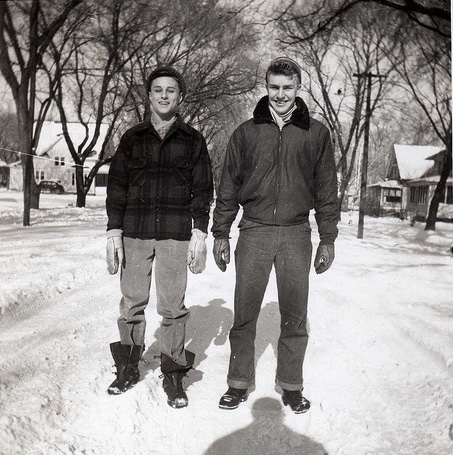
To pay my way through college, I worked as a tower hand for a tower services company in Cedar Rapids. For three years I spent my weekends climbing thousands of feet into the air to fix antennas, replace cables, and change light bulbs.
And that was the easy part–what I hated was the cold!
You see we did this year round–to include those Iowa winters where the temperature was freezing on the ground and even colder in the air, where winds would create wind chills easily below -20 degrees Fahrenheit.
Climbing those towers covered with ice I learned very quickly how to dress for extreme cold weather. We had clothing needs similar to that of an outdoor athlete, as the climb up and the work was physically taxing and would cause sweating, while at other times we needed extra insulation as we would be sitting still for hours performing delicate tuning work.
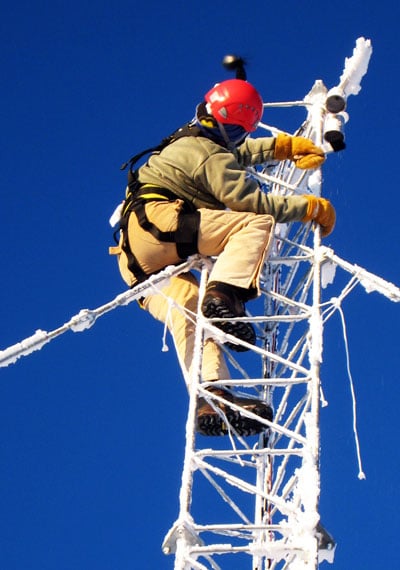
In order to add to the lessons I learned in the field on how to stay warm in freezing conditions, I spoke with the cold weather dressing experts at Carol Davis Sportswear and Northern Outfitters. And today I’ll be sharing the advice I gleaned from those conversations with you.
Understanding Layering
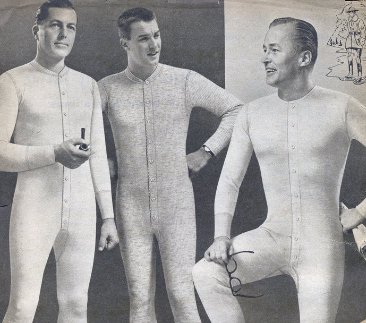
The key to cold weather dressing is layering.
Let me repeat that: The key to cold weather dressing is layering.
Layering basically means just what it sounds like: wearing multiple layers of garments, one on top of the next. Several lighter layers will keep you warmer than one very thick one–air is trapped between each layer and warmed by your body, surrounding you with a self-generated heat shield that insulates you from the cold.
Of course, some types of clothing do a better job than others. Layering regular street clothing until it will keep you warm in sub-zero temperatures will leave you so bulky that you might as well roll to wherever you’re going. That’s not our goal.

If you can’t put your arms down, you know your attempt at layering has gone terribly wrong.
Instead, seek out the right clothing for each layer and then use it accordingly for optimum cold weather insulation protection.
Experts break layering into three sections:
1) the base layer
2) the insulating layer
3) the outer protection layer
Let’s cover each layer in detail.
1. Base Layer
Your cold weather base layer lies against your skin and is primarily meant to provide the first layer of insulation and most importantly deal with moisture removal. Staying warm and active means occasionally sweating, and sweating is bad if your clothing doesn’t allow it to move out and away from your skin. Water on the skin in cold weather can turn deadly as it can lead to rapid heat loss, so ensure you use an inner layer that pulls sweat away from the body.
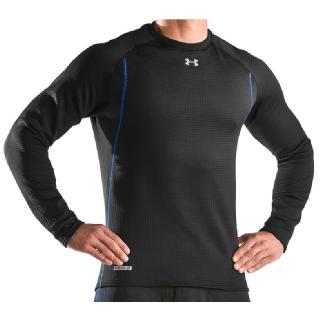 Old fashioned solutions mostly relied on garments made from loose wool strings, which absorbed the moisture and had enough thickness for it to soak toward the outside of the clothing. More modern solutions use synthetic fibers in much the same way.
Old fashioned solutions mostly relied on garments made from loose wool strings, which absorbed the moisture and had enough thickness for it to soak toward the outside of the clothing. More modern solutions use synthetic fibers in much the same way.
The process of drawing moisture away from the body is often referred to as “wicking.” Athletic and specialty cold weather garments are the best balance between moisture wicking properties and thin, lightweight construction. They add almost no bulk and if properly fitted allow extreme flexibility.
Your hands and feet need layers as well, and liner socks are key to any kind of warm weather outfit. Camping stores sell these quite inexpensively so don’t skip on this purchase; wear them under thicker socks to keep your feet dry. Fingerless liner gloves or very thin wool gloves make a useful base layer for the hands, where sweat is less of a concern but an extra layer still adds warmth by trapping air.
2. Insulating Layer
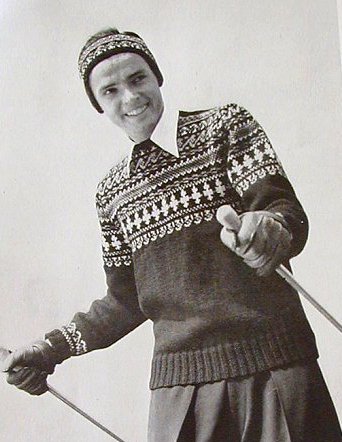
The job of your main insulating layer is to trap in heat.
Natural fibers like goose down and wool have excellent insulating properties. They provide a lot of heat for reasonably light weight, which is a concern for more active cold weather situations like skiing or hiking. Wool can absorb 30% of its weight and not feel wet and even continues to provide some insulation when soaked, while down loses its effectiveness when wet (but is lighter overall and has better insulating properties that wool).
Wool (to include cashmere and angora) sweaters are some of the dressiest options available that still provide serious winter warmth. A good wool sweater paired with a regular cotton dress shirt makes for a functional insulating layer for around the town needs on seriously cold days.
“Performance fleece”–actually a trademarked term, but widely used these days to describe any artificial fleece garment–is lightweight and a proven insulator. Its best property is that it continues to insulate when wet, but it offers little protection from the wind unless layered with a tightly woven, wind resistant fabric. These are often among the least expensive and most widely available options for insulating layers.
Thick wool or fleece trousers make the best insulating layer for your legs. Over a base layer they’re extremely warm. Jeans can serve as light protective wear, but they offer little if any insulating properties. Men that live and work in cold weather areas stay away from jeans unless they’ve been lined with an inner insulating layer.
3. Protective Layer
Your outer layer is the shell that keeps all the inner layers protected from the elements. It’s usually (though not always) a single layer, and doesn’t necessarily have to have any insulation.
The most important consideration for your protective layer is that it traps air and stops wind. It should also be breathable enough to allow moisture out–you don’t want your sweat trapped under your shell with you. That means that most outer layers are water-resistant but not fully water-proofed.
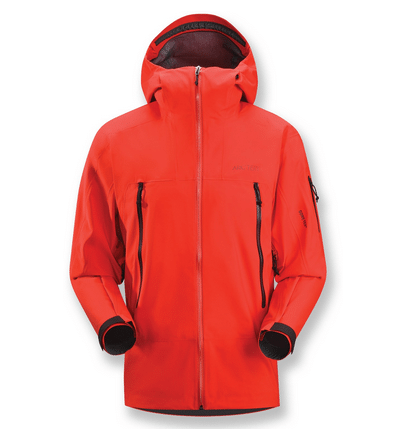
Most serious cold-weather shells are designed as outdoor gear. They don’t tend to have a lot of fashionable styling. If you’re primarily interested in dress or business clothing that can provide warmth as well, there are treated wool overcoats that have a windproofed layer or treatment with GOR-TEX and similar materials. Alternatively, buy your parka or shell in the plainest, darkest design you can find and don’t worry about it too much–once the temperature drops below zero people start making allowances for more functional-looking styles.
The outer layer also includes protection for your extremities. A layer of weather-proofed gloves or mittens and a wool stocking cap are the bare minimum of protection. An insulated headband, a scarf, and good winter boots also help. Waterproof hiking boots work up to a point, but in really cold weather the best winter boots are soft-sided, natural fiber-lined pieces with built-in insulation and thick, flexible soles.
I would like to note many cultures still make use of “skins” as natural outer protective layers. Any American visiting Ukraine during the winter will notice 1) that no one de-ices the sidewalks and 2) that everyone seems to own a large fur coat and ushanka.
Your Unique Situational Needs
Not all cold weather gear serves the same function. Someone who’s going dog sledding for a week needs a very different set-up from someone who wants to keep walking to work once the temperature drops below zero.
Cold Weather Active — Running, Cross-Country Skiing, Etc.

Winter sports enthusiasts need gear that’s lightweight as well as insulating and weatherproof. Dedicated joggers may even wind up skipping the outer shell layer entirely since their body temperature will stay high, they’ll be out for a limited amount of time, and breathability is key to comfort. Obviously, this only works for men who can step outside, do their activity, and step immediately back into a warm shelter. Anyone without that luxury will need the outer layer.
High-performance outdoor gear makes the best active cold weather gear. Synthetic fibers can provide much lighter-weight comfort than heavy wool and down. Two to three thin layers of warm jackets and leggings are ideal, topped off with an insulated headband and some weather-proofed gloves.
An outer/shell layer with its own insulation may be ideal for cold weather active situations since it can be worn during idle time, set-up of equipment, walking or other transportation, etc., and then removed when the intense activity starts.
Cold Weather Non-Active — Snowmobiling, Hunting, Etc.
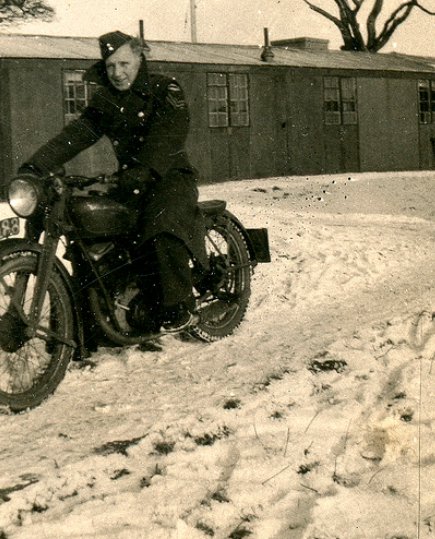
Men who are going to be sitting still for long periods need gear that’s more focused on trapping warmth and less on letting moisture and air breathe out.
Serious cold weather gear for people who are out all day (and not exercising hard) relies on thick insulating layers and a weatherproofed shell. If water isn’t a concern, a down layer paired with thinner wool layers and an artificial-fiber shell is perfect.
More layers are also needed, including on the feet and hands. A couple different thicknesses of socks, with a moisture-wicking liner sock, and a thick, insulated boot keeps the feet warm. Thin gloves should go under a thicker pair, which can in turn go into an insulated (and cuffed) pair of mittens that stay on until manual dexterity is needed.
Cold Weather Business Dress
Most office jobs don’t require a man to spend too much time outside in the winter. But if you happen to need to look a little sharp and it’s twenty below, what do you do?
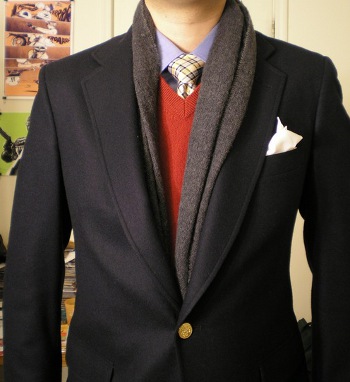
Image from The Silentist
Layering, as usual, is key. Wear your usual dress shirt and tie over a long-sleeved, moisture-wicking underlayer — cotton traps moisture well enough that you don’t want it against your body. A thin sweater on top of that (cashmere gives excellent warmth while remaining lightweight and compact) can go under a heavy worsted wool jacket. Wool trousers can be matched as a suit or odd trousers, and should go over good, thick long johns.
Wear the longest and heaviest wool overcoat you can find on top of it all, and if things get extreme, consider getting it treated with a DWR (durable water repellant), GOR-TEX, or similar coating. Thin dress socks in wool/synthetic blends are available at most camping stores these days, in conservative colors, and can be worn over a liner sock with your dress shoes. An insulated headband under a dress hat of the same color is usually presentable, or just wear a plain, dark stocking cap.
The Importance of Fit
Fit is important in winter wear as your layering clothes still have to allow freedom of movement–one poor fitting garment can restrict your ability to ski or work freely.
Your base layer should always be as closely fitted as possible. It’s there to absorb moisture from your skin, and it needs to be touching your body to do that effectively. Most good Under Armor-style garments have elastic or other stretchable material in them to allow a skintight fit.
Insulating layers should be stacked from the thinnest and tightest to the thickest and loosest. A light wool sweater doesn’t provide effective insulation if it’s stretched out over a puffy down vest. Wear multiple layers when you go to buy heavy winter jackets and other insulating garments to make sure they fit over all the layers you’ll be wearing in serious cold weather situations.
Shells should have a little looseness between them and the insulating layers. This helps with airflow and also with wetness–a water-resistant (but not fully waterproofed) surface is most likely to leak through when it presses against the clothes beneath it.
Cold Weather Gear – Piece by Piece
Hats: Insulated headbands for active exercise and warmer/sunnier days. Stocking caps for colder weather and stationary or light exercise. Balaclavas/ski masks for the coldest and windiest days–bring a couple, since they get wet and lose their effectiveness over time from your breath.
Goggles: Important protection from wind, which can make eyes tear up and lashes freeze. Dark lenses may also be needed if there’s lots of snow and sun.
Scarves: Vital wind protection. Always have one tucked under the shell layer.
Parkas: Big, insulated outer layers that reach down to the knees or lower. The most intense of outer layers. Bulky but very effective. Almost always include a hood for extra warmth.
Ski Jackets: Waist-length insulated jackets with a waterproofed or water-resistant exterior. Thinner and lighter than parkas, making them a little more versatile.
Weatherproof Shells: Soft garments made of treated fabric that stop wind and water but have little or no insulation of their own. Useful lightweight protection to pair with thick insulation layers.
Sweaters: A standard insulation layer. Wool is the best–thick, natural wool with the lanolin still in it is extremely durable and water-resistant, while lighter cashmere wool makes very lightweight garments that still provide good insulation.
Performance Fleece: Excellent for cold weather exercise. Very breathable, but not windproof at all, and tends to be bulky.
Snow Pants: Big, insulated pants (usually overall-style) with a waterproof or water resistant outer layer. Bulky but extremely warm. Made to fit over regular trousers.
Wool Trousers: Useful as both dress clothes and cold weather gear. Thicker wools add more warmth and can handle more wetness.
Flannel-lined Pants: Common in blue jeans and other work clothes. Adds a layer of insulation to regular, functional pants. Basically worthless when wet, however.
Snow Boots: Soft-sided boots with flexible soles and insulation on the insides. Usually waterproof.
Wool Socks: Vital layer for the feet. Can come quite thin in wool/synthetic blends, but the extra padding of thick wool socks helps trap more air for warmth.
Liner Socks: Synthetic socks meant to be worn under warmer socks. Useful for wicking moisture away from the feet.
Long Underwear: Wool or synthetic (or a blend of both). Makes a huge difference in keeping the legs warm.
Under Armor (and similiar type garments): Athletic-style moisture-wicking undershirts. Vastly preferable to plain cotton undershirts, which trap moisture and stay clammy.
Wool Gloves: Thin sock-style gloves used as an extra layer below thick gloves or mittens.
Ski Gloves: Or basic winter gloves; fingered gloves with padded insulation and weatherproof exteriors.
Mittens: Big, fingerless gloves. Can be made from insulation and a synthetic liner similar to ski gloves, or from natural sheepskin with the wool still attached and the leather side out.
Have Tony talk you through the tips:
Written by Antonio Centeno
Grab my Free 47 Page Ebook on Men’s Style
Watch my 130+ Men’s Style Videos


